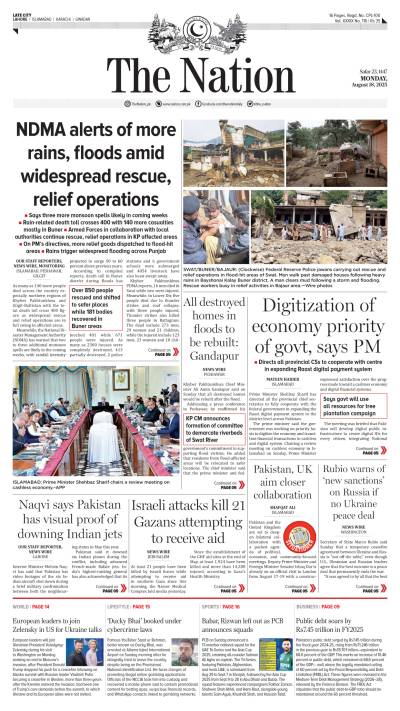The Covid-19 pandemic and its economic ramifications are posing an unprecedented challenge to countries’ social protection systems. In response to this, extraordinary social protection measures, ranging from policy adjustments and efforts to address social protection gaps, were taken across the world along with the provision of emergency support to the vulnerable. In Pakistan, inadequate medical capacity and a vulnerable economy that is undergoing a structural adjustment programme under the International Monetary Fund’s (IMF) Extended Fund Facility exacerbated the strain of the crisis which made emergency social protection interventions essential.
A number of social protection interventions, monetary interventions such as a cut in policy rate by the central bank, and flexible credit facilities were introduced by the government. Most notably, it introduced the Ehsaas Emergency Cash (EEC) programme, covering 5 million existing Ehsaas Kafaalat beneficiaries and new temporary beneficiaries who were either uncovered or ineligible before the pandemic. Identified through an SMS campaign, many of the new beneficiaries are daily labourers and informal workers whose livelihoods have been adversely affected by the corona-induced economic downturn. An immediate cash relief of Rs.12,000 was extended by the government to these families. Moreover, the Prime Minister launched a web-portal soliciting applications from those who have lost their jobs as a result of the pandemic and committed the Prime Minister’s Covid Pandemic Relief Fund to those qualifying for aid. These funds are being disbursed through the EEC programme.
When analysing the shock responsive social protection pathways, the following points are important to consider. Pakistan already has a social safety net in place which targets the poorest quintile of the population. Therefore, it might have been ideal to expand on the already existing cash transfer programmes. In that instance, a lot of people, including daily wage labourers, who have been adversely impacted by this pandemic crisis but weren’t part of any existing social safety net might have missed out. Hence, it was imperative to reach out to people who were not part of such safety nets, but desperately needed support.
In such a scenario, one option was to give out a one-time universal payment, such as in developed countries, but that means some of the money would have gone out to the undeserving people as well. Keeping in view the limited resources, this wasn’t a viable option and the approach of targeted support was better suited. Hence, the EEC programme that leveraged on the existing Ehsaas infrastructure was launched and it has effectively targeted the vulnerable segment of the society.
Fortunately, over the past decade, Pakistan has developed asocial safety net structure which provided a foundation to expand upon and deliver shock responsive aid efficiently in form of the Ehsaas Emergency Cash Programme. However, this piggyback model through which the existing systems of Ehsaas are being utilised is a short-term intervention. Though helpful, it doesn’t cover broader aspects of social protection such as enabling the poor to graduate out of poverty. This will be a critical factor in offsetting the adverse impact of the pandemic in the long run.
A strong sustainable social protection system guides the beneficiaries towards self-sufficiency and enables them to earn their own livelihoods, addressing inequality as a result, ensuring social inclusion and empowering the vulnerable. During the pandemic cinduced joblessness, it is essential that the social protection framework sprioritise the vulnerable, provide access to health services, support people in adopting necessary prevention measures, ensure income security, protect human capabilities and livelihoods, scale up and strengthen already existing social protection programmes and its delivery capacities and design crisis response measures with a view to strengthen social protection systems in the long term.
The Ehsaas programme has done well but the harsh reality is that there is a need to improve the existing social protection mechanism, build state capabilities, make shock responsive social protection a permanent feature and transition to a broader comprehensive scale of welfare for a better, inclusive and sustainable future. Hopefully, the Covid-19 pandemic would turn out to be a turning point in the social protection domain in Pakistan.
Monday, August 18, 2025
Is Covid-19 a turning point in social protection?
Mahroo Arshad
U23 camp shifted from Abbottabad to Islamabad
6:37 PM | August 18, 2025
PFF delegation visits AFC Headquarters to discuss Football Development in Pakistan
5:21 PM | August 18, 2025
Rupee gains 05 paisa against US Dollar
4:56 PM | August 18, 2025
China finish record haul in Chengdu with breaking and skating golds
4:50 PM | August 18, 2025
China says ‘glad’ to see US, Russia improve ties after Trump-Putin meeting
3:46 PM | August 18, 2025
-
'No talk of President Zardari resigning or COAS seeking Presidency': Naqvi rejects rumours
-
'No talk of President Zardari resigning or COAS seeking Presidency': Naqvi rejects rumours
-
Pilgrims perform final Hajj ritual as Eidul Azha begins amid tight security and heat measures
-
Hajj 2025 sermon: Imam-e-Kaaba prays for Palestine, urges unity and compassion
-
Nearly 2 million Muslim pilgrims ascend Mt Arafat for climax of Hajj pilgrimage
-
How the US repeatedly failed to deliver aid to the people of Gaza
Drowning in Denial
August 17, 2025
A Fragile Peace
August 17, 2025
A Regional Opening
August 17, 2025
Broadening Horizons
August 16, 2025
Code of Care
August 16, 2025
Olympics 2028
August 17, 2025
Alarming Rise in Youth Unemployment
August 17, 2025
Pakistan Turns 78
August 17, 2025
Reviving Night Cricket
August 17, 2025
Unpaid Internships — A Barrier to Talent
August 16, 2025
ePaper - Nawaiwaqt
Nawaiwaqt Group | Copyright © 2025







